What is Conversion Therapy and why it needs to be banned?
I am Pamal Mahla from Punjab. My father and mother are teachers by profession. I studied political science from University of Delhi. Reading books and writing poetry and articles are my hobby. I love writing.
Two new legal challenges are targeting conversion therapy. The first is a civil suit in New Jersey in which four former clients of a counseling group called Jonah are suing for deceptive practices. The patients argue they paid thousands of dollars for therapies that did not rid them of same-sex attractions, and that they then had to pay for mainstream therapy to repair the damage done by the conversion therapy.
In a second case in California, a federal judge is hearing arguments against a new state law that bans conversion therapy for minors. The bill was signed into law in September. Conservative legal groups claim the law is a violation of the right to free speech, freedom of religion and privacy.
What is Conversion Therapy?
Conversion therapy refers to procedure offered by hospital or religious institutions by which they falsely claim to medically cure LGBTQI + persons or change transgender people into cisgender so that their gender corresponds into their birth sex.
Conversion therapy refers to any of several dangerous and discredited practices aimed at changing an individual’s sexual orientation or gender identity. For example, that could mean attempting to change someone’s sexual orientation from lesbian, gay, or bisexual to straight or their gender identity from transgender or nonbinary to cisgender. And it could include efforts to change a person’s gender expression or to reduce or eliminate sexual or romantic attraction or feelings toward a person of the same gender.
Conversion therapy can come in many forms and is sometimes known by other names, including:
- Gender critical therapy
- Reparative therapy
- Ex-gay ministries
- Sexual orientation and gender identity change efforts
Conversion therapy can be performed by licensed professionals, unlicensed ministries, or life coaches. It can be done one-on-one in an office or in groups at retreats or conferences and it can be done for money or for free. Faith-based conversion therapy can be found across a wide range of religious traditions; faith communities have also played an important and growing role in protecting LGBTQ youth from conversion therapy.
What happens in Conversion Therapy
When conversion therapy was introduced in India, it involved using electro-convulsive therapy as well as a programme of behavioural therapy to remove fear or anxiety of the opposite sex. Patients would attend sessions with a range of erotic or pornographic same-sex photographs. Along with that they receive an electric shock, creating a negative association of pain with their own feelings of arousal.
The photographs would then be replaced with a heterosexual image and the electric shock would subside, assigning a sense of relief to opposite-sex attraction. While visual aids were the primary stimuli, Indian practitioners also included sensory materials, such as women’s perfume, to elicit stronger positive relations with opposite-sex stimuli. Women’s perfumes are still being used today according to recent accounts of conversion therapy.
As per 2004 article in the British Medical Journal, conversion therapy is not a mainstream psychological treatment, there are no professional standards or guidelines for how it is conducted.
Other methods included psychoanalysis or talk therapy, estrogen treatments to reduce libido in men, and even electroconvulsive therapy, in which an electric shock is used to induce a seizure, with side effects such as memory loss.
More recently, people who have been through conversion therapy report talk therapy that emphasizes pseudoscientific theories, such as the idea that an overbearing mother and a distant father make a child gay. In an April 2012 essay in The American Prospect, writer Gabriel Arana describes his “ex-gay” therapy experience. His therapist blamed his parents for Arana’s homosexuality, and urged him to distance himself from his female best friends.
Chaim Levin, one of the men suing Jonah for deceptive practices, says that he quit conversion therapy after his therapist had him strip down and touch himself to “reconnect with his masculinity,” according to the New York Times.
Groups that promote conversion therapy often point to a single study to support their work. In 2003, famed psychiatrist Robert Spitzer, who spearheaded the removal of homosexuality from the American Psychiatric Association’s mental disorder list in 1973, reported in the journal Archives of Sexual Behavior that interviews with conversion therapy patients suggested that some people could change their sexual orientation.
Historical cases
While conversion therapy has had a long and troubling history throughout the world, among the early recorded cases of a “medical” attempt was by Viennese endocrinologist Eugen Steinach. Steinach transplanted “testicles from straight men into gay men in attempts to change their sexual orientation” — a procedure that was later established to be not only ineffective, but also harmful.
Yet another controversial medical treatment was popularised by American neurologist Walter Freeman in the 1940s and ’50s: He used an ice pick to lobotomise homosexual individuals, claiming the procedure would “cure” them. Instead, it left most of his patients severely and permanently disabled.
Recent cases
Last May, conversion therapy was back in the headlines in India when a 21-year-old from Kerala died by suicide. Anjana Harish, a bisexual woman, said she had been forced to undergo conversion therapy by her family in which she was assaulted and sedated, then placed in isolation, followed by a course of heavy medication. In a video posted to Facebook, she said, “My own family did this to me, that’s what saddens me the most”. Two months after sharing her narrative, she was dead.
Recently, a 23-year-old lesbian woman from Tamil Nadu, Pavithra, spoke with a German news publication about her family’s attempts to force her to undergo conversion therapy. This included visits to a general physician followed by a consultation with a psychiatrist who advised Pavithra to watch porn videos depicting heterosexual intercourse. Pavithra’s family also took her to a quack who “prescribed” rum as medication, and an unidentified tablet. She finally fled from her home and has been living with her partner Mary.
The same report also quotes Rajashree Raju, a member of the Kerala-based LGBTQ activism group Queerala, as saying that instances of individuals being forced to undergo conversion therapy had doubled during the pandemic-induced lockdown.
Where is conversion therapy banned?
Malta, Brazil, Taiwan, Ecuador, Germany have bans in place on conversion therapy. The practice has been criminalised in Canada and Albania. In addition, some US states have protections for LGBTQ individuals against conversion therapy. The UK has also been mulling a ban.
Tamil Nadu is set to be the first state to ban ‘conversion therapy’, a widely available procedure that hospitals as well as religious institutions offer to change the sexual orientation of LGBT people.
Underlining that sexual autonomy is an essential aspect of the right to privacy, the Madras High Court recently issued far-reaching guidelines aimed at mainstreaming LGBTIQA+ persons — from prohibiting attempts to “medically cure” persons belonging to the community to seeking changes in school and university curricula and recommending awareness programmes for judicial officers, police and prison officials.
The order was issued by Justice N Anand Venkatesh on a plea filed by a lesbian couple whose relationship was being opposed by their parents. After they fled their homes in Madurai to live in Chennai, families of the petitioners had filed missing person complaints with the police, eventually leading to the registration of two FIRs and the couple being interrogated. The petitioners had moved the Madras High Court seeking protection against police harassment and from any threat or danger to their safety and security.
Conclusion
In 2020 the International Rehabilitation Council for Torture Victims released an official statement that conversion therapy is torture. The same year, UN Independent Expert on sexual orientation and gender identity, Victor Madrigal-Borloz, said that conversion therapy practices are “inherently discriminatory, that they are cruel, inhuman and degrading treatment, and that depending on the severity or physical or mental pain and suffering inflicted to the victim, they may amount to torture”. He recommended that it should be banned across the world.
Epitomizing this, there is clear evidence that conversion therapy does not work, and some significant evidence that it is also harmful to LGBTQ people. Therefore it should be banned all over the world and people’s sexuality and their personal choices need to be respected.
References
- Harry Farley & Eleanor Lawrie, (2021) What is conversion therapy and when will it be banned? BBC.
- Arun Janardhanan, (2021) ‘Cure therapy’ ban to training for police: Madras HC reaches out to LGBTQ, Indian express.
- FP STAFF, (2021) Explainer: As Madras HC prohibits conversion therapy, a look at history of traumatic ‘cures’ for queer individuals, First post.
- Stephanie Pappas, (2012) 5 Things You Should Know About Gay Conversion Therapy, Live Science.
- Bhanuj Kappal, (2020) The pain and cruelty of conversion therapy, The mint.
- Rianna price, (2020) LGBTQ+ conversion therapy in India: how it began and why it persists today, The conversation.








